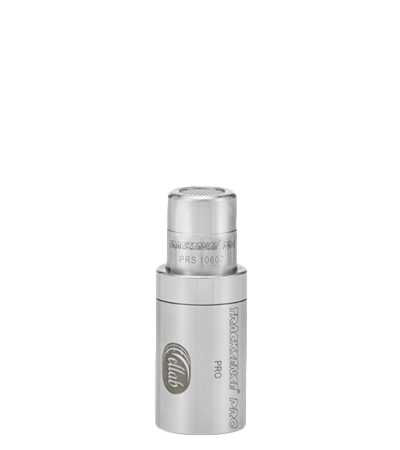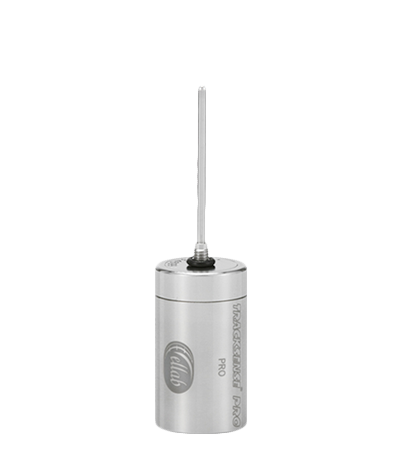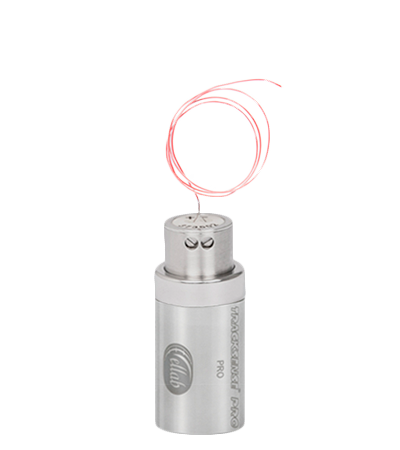UHT and HTST Pasteurization
- Complete solutions for qualification and validation
Ellab offers a wide range of options to fit your UHT and HTST Pasteurization needs. View our recommended solutions and learn more about the requirements for UHT and HTST Pasteurization.
Recommended Solutions for UHT and HTST Pasteurization
Validation
UHT and HTST Pasteurization are highly regulated, thermal processes that revolves around sterilizing liquid products (typically food) prior to packaging. The goal of the thermal process is to sterilize foods and beverages like milk, juice, dressing and yogurt, while ensuring that they keep their sensory appeal and become shelf-stable products.
A typical design of a UHT and HTST Pasteurization plant setup includes:
- Heat exchanger – either plate type PHE (usually for low viscosity and no particulates products) or tubular type THE
- Holding tube – sized to ensure the correct treatment time is achieved
- Surge tank
- Control and monitoring system
UHT Pasteurization and HTST Pasteurization are typically defined as follows:
High Temperature/Short Time (HTST) Pasteurization
HTST Pasteurization is by far, the preferred method of pasteurization, where the product is heated to 72 °C for approx. 15 seconds.
Ultra-High Temperature (UHT) Pasteurization
At UHT Pasteurization, the product (particularly milk) is heated to 130-150 °C for 0.5-1.0 second. This is considered by some to be a sterilization process, rather than pasteurization, and results in a significantly longer shelf life.
During HTST Pasteurization
HTST Pasteurization, sometimes referred to as “flash pasteurization”, is a continuous thermal process, where:
- The cold (4 °C) raw product is fed into the plant
- It passes through the plate heat exchanger,
where temperatures rise to 72 °C - It then proceeds into the holding tube passage for 15 seconds
- The product is then sent back through the regenerative section, where it is cooled down to approx. 32 °C before it is returned through the heat exchanger, ending up with an exit temperature of 4 °C
UHT Pasteurization involves a preheating process, followed by exposure to high temperatures of 130-150 °C for 0.5–1.0 second.
During UHT Pasteurization:
- The product is pumped through an air removal system to the heat exchanger.
- After heating the product, it passes through the holding tube where it receives the required time-temperature effect
- It then proceeds through to the cooling unit (heat exchanger), where it is cooled to preserve the nutrients and flavor components before entering the packaging unit.
CIP and SIP Procedures
Once a product is fully processed in either a UHT or HTST Pasteurization cycle, the system has to undergo a Clean-In-Place (CIP) operation, which usually involves sequences of hot water and alkali/acid solutions. This should ensure clean surfaces and lessen the risk of later fouling (clotting), as clotting could affect the rate of heat transfer and the residence time of the product.
At regular intervals, the entire equipment setup in the UHT and HTST Pasteurization process needs to be Sterilized-In-Place (SIP), where steam, H2O2, radiation or a combination of these methods are used. For the filling lines, sterilization is performed by using steam or water at high pressure – usually at 121 °C for 30 minutes. Sterilization of the surge tank however, needs to be performed by saturated steam due to the large volume.
Process
UHT and HTST Pasteurization validation processes are typically divided into 3 parts:
- Qualifying the tanks with regard to the maximum temperature and temperature uniformity (distribution) in order to prove sterility, i.e. a sufficient SIP procedure (Sterilization-In-Place) between every production run.
- Validating the temperature/time profile obtained through the holding tube to prove that sufficient heating is obtained in order to define a product as aseptic/sterile. It is in this connection also important to determine the exit temperature of the product from the holding tube.
- Validating possible temperature differences across the pipelines and holding tube to detect when possible fouling occurs (blockage of flow). If the piping proves to be clean, temperature variation between holding tube inlet and outlet is typically within 0.3 to 0.5 °C, whereas fouling will increase this value to 1-4 °C, indicating resistance building up inside the tube. Upon experiencing fouling, new CIP/SIP must be performed.
With regard to sterility, there are two approaches that are implemented in UHT and HTST Pasteurization systems, namely the Over-Kill Approach, where bio indicators and spore strips of surrogate microorganisms are used, and the Log Reduction method, where Ellab Validation systems are essential to sample accurate temperature/pressure data.
Microbial Challenge in UHT and HTST Pasteurization:
A Microbial Challenge is performed by e.g. using spores, where tests are performed during different stages of the process – just after starting it up, in the middle and just prior to the end. These tests are mainly used to identify variations during the process as a function of time. They are however, rather expensive and provide no immediate results.
Thermal Mapping and the Log Reduction Method for UHT and HTST Pasteurization:
Using parametric data, which involves measuring temperature and/or pressure, is a very reliable method that provides immediate results. Conducting Thermal Mapping (a Heat Distribution Study) in the Surge/Aseptic Tank is the very first stage in every validation procedure of UHT and HTST Pasteurization. This is performed to ensure that the correct and adequate Sterilization-In-Place (SIP) process is brought to the tank, as it is the final location of the product before it is pumped to the filler machines.
Once the mapping and identification of the cold spot (critical point) are complete, sensors are placed, and multiple consecutive SIP cycles are performed to prove that sterility is obtained. This is done by calculating the F0 value (log 6 or 12 reduction).
Challenges
Validating a continuous aseptic process, such as UHT or HTST pasteurization, includes several considerations, of which identifying the locations of the critical point is of most importance. Critical points are the slowest reacting part of the system, these are especially important to locate within the holding tube. The cold spot could be located in the center of a tube, or in other geometric places depending on the type of product. This therefore has to be defined prior to validating UHT or HTST Pasteurization by using mathematic modelling combined with actual measurements.
As the UHT and HTST Pasteurization equipment is rather large in size, one of the biggest challenges is the placement of the measuring devices. Due to this issue, wireless data loggers are highly recommended as they pose no limitations to range.
Another challenge is the ability to measure the actual product temperature inside the pasteurization system. To do this, it may be necessary to mount Smart Gaskets or special insertions valves (Janz valves), which are welded onto the piping at the critical points, allowing sensors to be inserted through a tightening membrane system. If this is not possible, another solution could be to measure the surface temperature on the outside of the pipe – and make temperature correlations to compensate for the differences.
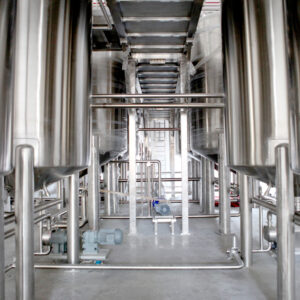
Get Equipment
Get your own Ellab equipment to validate, qualify and monitor your processes.
Rent Equipment
Rent Ellab equipment for projects of any size and try our solutions before you commit.
Field Service and Consulting
Get on-site validation, qualification and calibration services as well as expert GMP consulting.
Easily Secure Your Measuring Points with Fittings
Unlock new possibilities with fittings and accessories
Fittings and Accessories are crucial for your process to gain the most accurate results. Fix your measuring points at the exact points of interest for the complete overview.
Rent the Ultimate Validation Equipment Now
- and try it before you buy it
Whether you need supplemental or complete turn-key rentals, Ellab has the solution for you. Rent our wireless data loggers, thermocouple system, leading validation software and more!
Need Help Qualifying and Validating Your Valuable Process?
Our skilled Validation Team stands ready to serve
Ellab’s Validation Service provides a professional team of validation technicians to complete any challenge you may have. Whether it’s routine validations/qualifications or large projects, we have the solution.
Guidelines
UHT and HTST Pasteurization must comply with applicable standards and be qualified and validated.
There are several Food Standards covering these processes, such as the AS 3993 (2003), NZFSA (2003), the Time-Temperature standards for Pasteurization and UHT published by the U.S. Public Health Service, as well as the FDA’s CFR Title 21, Parts 110, 113 and 114.
General Equipment Guidelines:
- ISO 9001 Certification
- FDA/USDA & EEC Guidelines
- CE & UL Approvals
- cGMP or GAMP5
- ISO/IEC 12207 Software life cycle processes
- Guidelines issued by local authorities
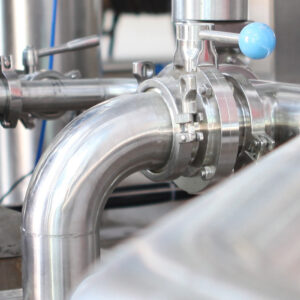
Method
The importance of validating UHT and HTST Pasteurization serves to ensure that the parameters used for a product, aside from ensuring that they are adequate, are producing a safe thermally-processed product and at the same time do not compromise the desired quality and sensory attributes of the product.
The results of the measurements should also be able to provide the following:
- Determine the spatial and temporal distribution of temperature within the product, ensuring adequate treatment and food safety
- The temperature profile (temporally and spatially) should provide the information used for calculating the lethality (F0/P0) value
- Provide a guide to mathematical modeling of the process and improved process control
Standard Operating Procedure (SOP) Points for Surge Tanks:
Using the E-Val Pro thermocouple system is possible but could prove to be rather difficult as it involves some considerable hazards. It may be difficult to manage large tanks with 7-meter cables, considering the need for sensors to be positioned strategically correct inside the tank.
Using the wireless TrackSense Pro data logger system is the far better option in this case, as data loggers can be placed anywhere. By attaching loggers tightly with e.g. a sanitized string, rope or by using a strong adhesive tape and the FixPro silicone logger holding system, they can be positioned at the appropriate locations inside the tanks.
Standard Operating Procedure (SOP) Points for Aseptic Line/ Holding Tube:
Using the E-Val Pro for aseptic lines is not always easy, as 7-meter standard length SSA thermocouples may not be able to cover all sections of a large UHT/aseptic system. Needless to say, this can prove to be rather challenging. When thermocouples cannot be positioned at the critical areas of the UHT or HTST Pasteurization process by using an insertion valve (Janz) or Smart Gasket, an alternative could be to use type MHD surface probes placed on the outside of the pipe. When using surface probes however, it might be necessary to consider the offsets, which in turn makes it important for validation officers to position it closest to the pipe that has a calibrated temperature sensor installed.
Using TrackSense Pro data loggers is by far more efficient for UHT and HTST Pasteurization, as the challenges of validating or measuring the critical areas of a widely-designed, continuous heat treatment system (which is common for HTST and Hot-Fill-Hold systems), can be answered by using a wireless data logger system. This process can be optimized even further by using the SKY real time data option.
In order to validate the UHT and HTST Pasteurization processes according to the predefined acceptance criteria, the ValSuite™ software is ideal when using the following standard facilities and reports.
- F0 report: Calculation of the lethality value
- Comments: Specifications and photos of test equipment
- Limit Report: Temperature
- Unit: Mapping of measuring points – includes pictures
- Time Event Markers: Heating zone, Heat treatment zone, Cooling zone (sub-zones)
- Advanced Validation Report: Temperature and P-Unit evaluation of the whole process criteria with pass/fail indicators
- Statistic Reports: The Min., Max., Average and Delta values of all parameters
- Word Document: SOP presentation
